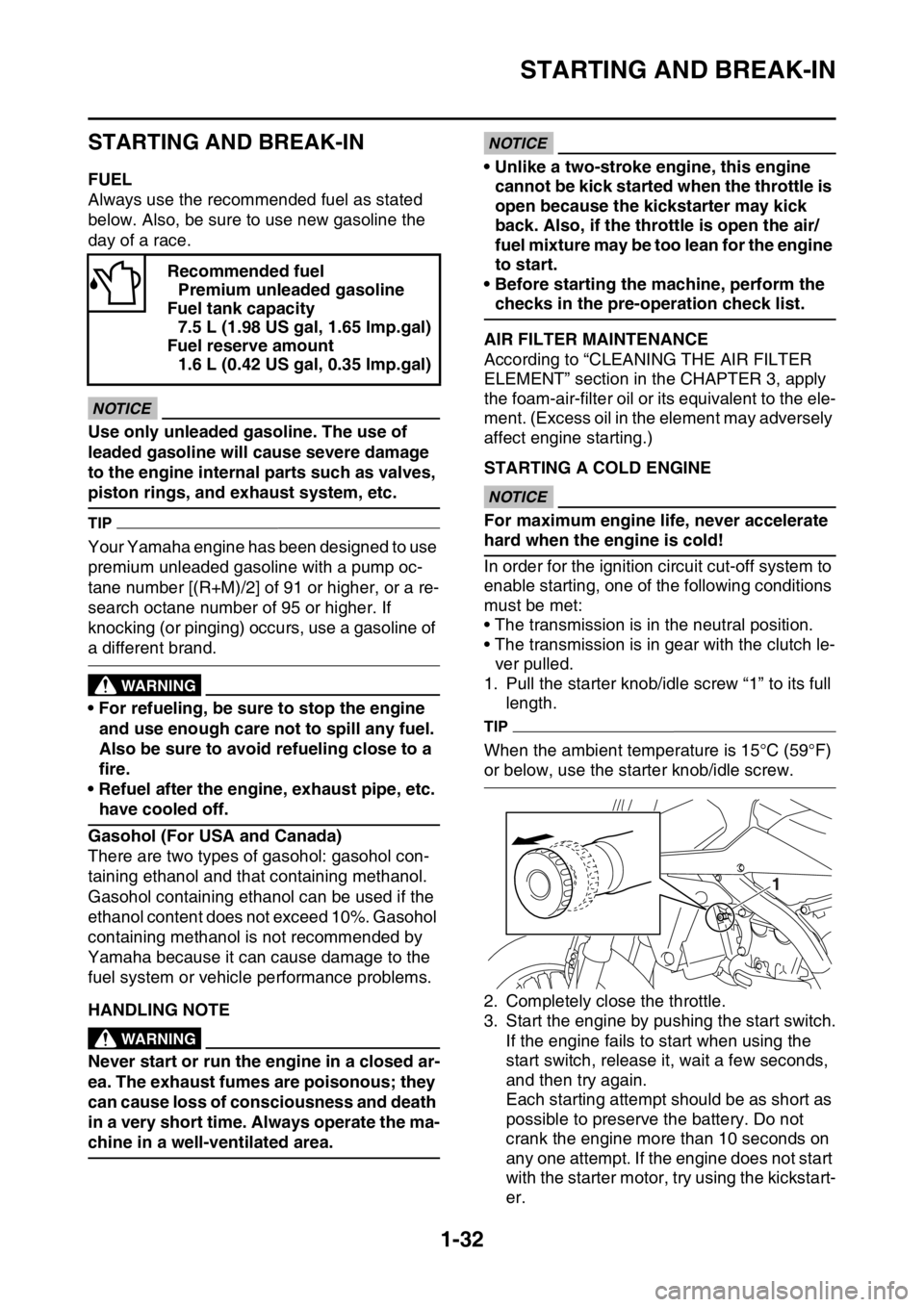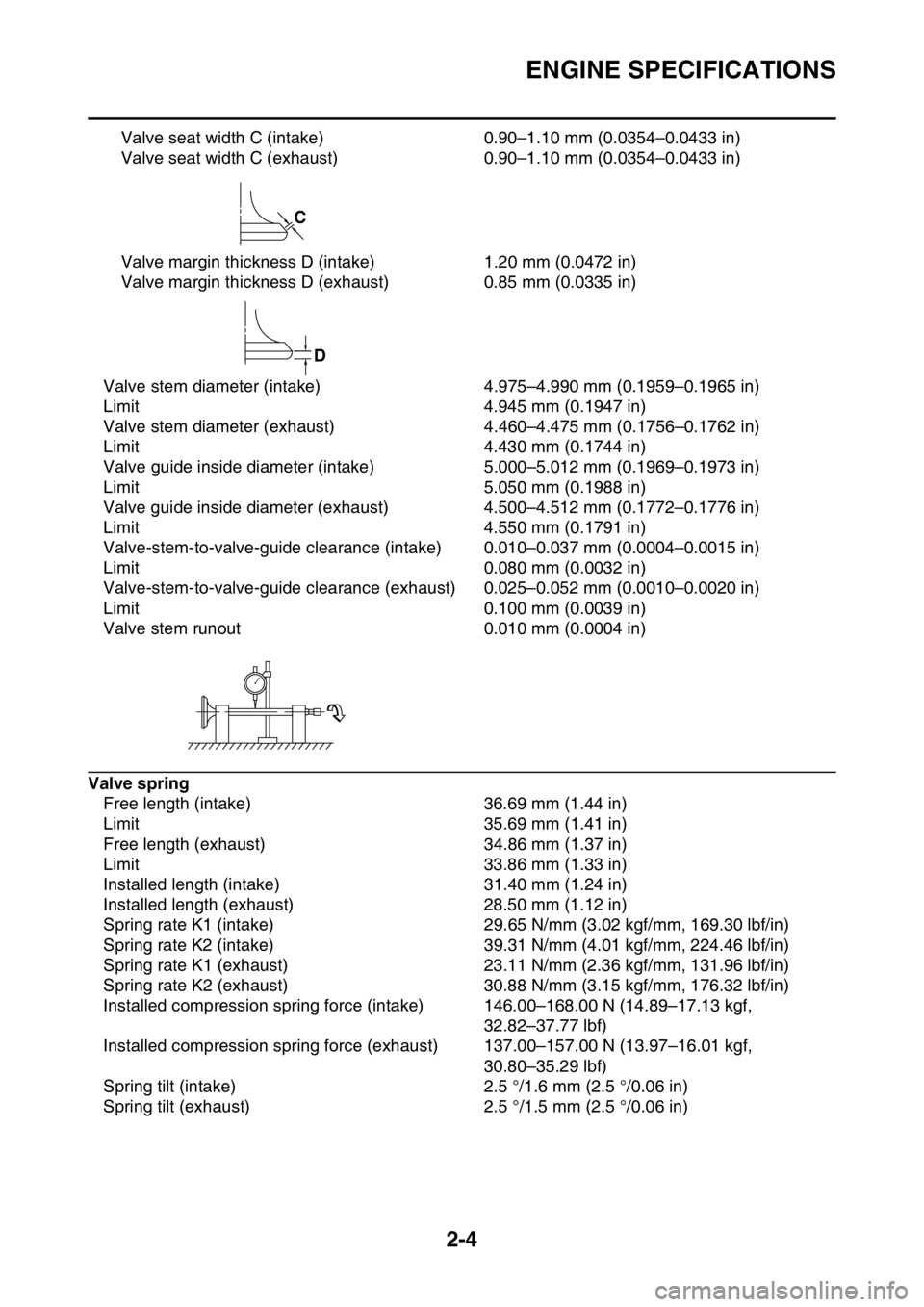length YAMAHA WR 250F 2015 Owners Manual
[x] Cancel search | Manufacturer: YAMAHA, Model Year: 2015, Model line: WR 250F, Model: YAMAHA WR 250F 2015Pages: 430, PDF Size: 14.14 MB
Page 7 of 430

EAS2GB2005
SAFETY INFORMATION
THIS MACHINE IS DESIGNED STRICTLY FOR COMPETITION USE, ONLY ON A CLOSED
COURSE. It is illegal for this machine to be operated on any public street, road, or highway. Off-road
use on public lands may also be illegal. Please check local regulations before riding.
• THIS MACHINE IS TO BE OPERATED BY AN EXPERIENCED RIDER ONLY.
Do not attempt to operate this machine at maximum power until you are totally familiar with its char-
acteristics.
• THIS MACHINE IS DESIGNED TO BE RIDDEN BY THE OPERATOR ONLY.
Do not carry passengers on this machine.
• ALWAYS WEAR PROTECTIVE APPAREL.
When operating this machine, always wear an approved helmet with goggles or a face shield. Also
wear heavy boots, gloves, and protective clothing. Always wear proper fitting clothing that will not
be caught in any of the moving parts or controls of the machine.
• ALWAYS MAINTAIN YOUR MACHINE IN PROPER WORKING ORDER.
For safety and reliability, the machine must be properly maintained. Always perform the pre-oper-
ation checks indicated in this manual.
Correcting a mechanical problem before you ride may prevent an accident.
• GASOLINE IS HIGHLY FLAMMABLE.
Always turn off the engine while refueling. Take care to not spill any gasoline on the engine or ex-
haust system. Never refuel in the vicinity of an open flame, or while smoking.
• GASOLINE CAN CAUSE INJURY.
If you should swallow some gasoline, inhale excess gasoline vapors, or allow any gasoline to get
into your eyes, contact a doctor immediately. If any gasoline spills onto your skin or clothing, imme-
diately wash skin areas with soap and water, and change your clothes.
• ONLY OPERATE THE MACHINE IN AN AREA WITH ADEQUATE VENTILATION.
Never start the engine or let it run for any length of time in an enclosed area. Exhaust fumes are
poisonous. These fumes contain carbon monoxide, which by itself is odorless and colorless. Car-
bon monoxide is a dangerous gas which can cause unconsciousness or can be lethal.
• PARK THE MACHINE CAREFULLY; TURN OFF THE ENGINE.
Always turn off the engine if you are going to leave the machine. Do not park the machine on a slope
or soft ground as it may fall over.
• THE ENGINE, EXHAUST PIPE AND MUFFLER WILL BE VERY HOT AFTER THE ENGINE HAS
BEEN RUN.
Be careful not to touch them or to allow any clothing item to contact them during inspection or repair.
• PROPERLY SECURE THE MACHINE BEFORE TRANSPORTING IT.
For safety, drain the gasoline from the fuel tank before transporting the vehicle.
Page 21 of 430

FEATURES
1-7
EAS2GB2015FI SYSTEM
The fuel pump delivers fuel to the fuel injector via the fuel filter. The pressure regulator maintains the
fuel pressure that is applied to the fuel injector at only 324 kPa (3.24 kgf/cm
2, 47.0 psi). Accordingly,
when the energizing signal from the ECU energizes the fuel injector, the fuel passage opens, causing
the fuel to be injected into the intake manifold only during the time the passage remains open. There-
fore, the longer the length of time the fuel injector is energized (injection duration), the greater the
volume of fuel that is supplied. Conversely, the shorter the length of time the fuel injector is energized
(injection duration), the lesser the volume of fuel that is supplied.
The injection duration and the injection timing are controlled by the ECU. Signals input from the throt-
tle position sensor, the coolant temperature sensor, the crankshaft position sensor, the intake air
pressure sensor, and the intake air temperature sensor enable the ECU to determine the injection
duration. The injection timing is determined through the signals from the crankshaft position sensor.
As a result, the volume of fuel that is required by the engine can be supplied at all times in accordance
with the driving conditions.
1. Fuel pump
2. Fuel injector
3. ECU
4. Throttle position sensor
5. Coolant temperature sensor
6. Crankshaft position sensor
7. Intake air pressure sensor
8. Throttle body
9. Intake air temperature sensor
10.Air filter case
A. Fuel system
B. Intake system
C. Control system
1
23
5
6 7
8 9 10A
BC
4
Page 46 of 430

STARTING AND BREAK-IN
1-32
EAS2GB2050
STARTING AND BREAK-IN
EAS2GB2051FUEL
Always use the recommended fuel as stated
below. Also, be sure to use new gasoline the
day of a race.
ECA
NOTICE
Use only unleaded gasoline. The use of
leaded gasoline will cause severe damage
to the engine internal parts such as valves,
piston rings, and exhaust system, etc.
TIP
Your Yamaha engine has been designed to use
premium unleaded gasoline with a pump oc-
tane number [(R+M)/2] of 91 or higher, or a re-
search octane number of 95 or higher. If
knocking (or pinging) occurs, use a gasoline of
a different brand.
EWA
WARNING
• For refueling, be sure to stop the engine
and use enough care not to spill any fuel.
Also be sure to avoid refueling close to a
fire.
• Refuel after the engine, exhaust pipe, etc.
have cooled off.
Gasohol (For USA and Canada)
There are two types of gasohol: gasohol con-
taining ethanol and that containing methanol.
Gasohol containing ethanol can be used if the
ethanol content does not exceed 10%. Gasohol
containing methanol is not recommended by
Yamaha because it can cause damage to the
fuel system or vehicle performance problems.
EAS2GB2052HANDLING NOTEEWA
WARNING
Never start or run the engine in a closed ar-
ea. The exhaust fumes are poisonous; they
can cause loss of consciousness and death
in a very short time. Always operate the ma-
chine in a well-ventilated area.
ECA
NOTICE
• Unlike a two-stroke engine, this engine
cannot be kick started when the throttle is
open because the kickstarter may kick
back. Also, if the throttle is open the air/
fuel mixture may be too lean for the engine
to start.
• Before starting the machine, perform the
checks in the pre-operation check list.
EAS2GB2053AIR FILTER MAINTENANCE
According to “CLEANING THE AIR FILTER
ELEMENT” section in the CHAPTER 3, apply
the foam-air-filter oil or its equivalent to the ele-
ment. (Excess oil in the element may adversely
affect engine starting.)
EAS2GB2054STARTING A COLD ENGINEECA
NOTICE
For maximum engine life, never accelerate
hard when the engine is cold!
In order for the ignition circuit cut-off system to
enable starting, one of the following conditions
must be met:
• The transmission is in the neutral position.
• The transmission is in gear with the clutch le-
ver pulled.
1. Pull the starter knob/idle screw “1” to its full
length.
TIP
When the ambient temperature is 15°C (59°F)
or below, use the starter knob/idle screw.
2. Completely close the throttle.
3. Start the engine by pushing the start switch.
If the engine fails to start when using the
start switch, release it, wait a few seconds,
and then try again.
Each starting attempt should be as short as
possible to preserve the battery. Do not
crank the engine more than 10 seconds on
any one attempt. If the engine does not start
with the starter motor, try using the kickstart-
er. Recommended fuel
Premium unleaded gasoline
Fuel tank capacity
7.5 L (1.98 US gal, 1.65 lmp.gal)
Fuel reserve amount
1.6 L (0.42 US gal, 0.35 lmp.gal)
1
Page 56 of 430

GENERAL SPECIFICATIONS
2-1
EAS2GB2063
GENERAL SPECIFICATIONS
Model
Model 2GB1 (USA)
2GB2 (CAN)
2GB3 (EUR)
2GB4 (AUS) (NZL) (ZAF)
Dimensions
Overall length 2165 mm (85.2 in)
Overall width 825 mm (32.5 in)
Overall height 1280 mm (50.4 in)
Seat height 965 mm (38.0 in)
Wheelbase 1465 mm (57.7 in)
Ground clearance 325 mm (12.8 in)
Weight
Curb weight 117 kg (258 lb) (USA) (CAN)
118 kg (260 lb) (EUR) (AUS) (NZL) (ZAF)
Page 59 of 430

ENGINE SPECIFICATIONS
2-4
Valve seat width C (intake) 0.90–1.10 mm (0.0354–0.0433 in)
Valve seat width C (exhaust) 0.90–1.10 mm (0.0354–0.0433 in)
Valve margin thickness D (intake) 1.20 mm (0.0472 in)
Valve margin thickness D (exhaust) 0.85 mm (0.0335 in)
Valve stem diameter (intake) 4.975–4.990 mm (0.1959–0.1965 in)
Limit 4.945 mm (0.1947 in)
Valve stem diameter (exhaust) 4.460–4.475 mm (0.1756–0.1762 in)
Limit 4.430 mm (0.1744 in)
Valve guide inside diameter (intake) 5.000–5.012 mm (0.1969–0.1973 in)
Limit 5.050 mm (0.1988 in)
Valve guide inside diameter (exhaust) 4.500–4.512 mm (0.1772–0.1776 in)
Limit 4.550 mm (0.1791 in)
Valve-stem-to-valve-guide clearance (intake) 0.010–0.037 mm (0.0004–0.0015 in)
Limit 0.080 mm (0.0032 in)
Valve-stem-to-valve-guide clearance (exhaust) 0.025–0.052 mm (0.0010–0.0020 in)
Limit 0.100 mm (0.0039 in)
Valve stem runout 0.010 mm (0.0004 in)
Valve spring
Free length (intake) 36.69 mm (1.44 in)
Limit 35.69 mm (1.41 in)
Free length (exhaust) 34.86 mm (1.37 in)
Limit 33.86 mm (1.33 in)
Installed length (intake) 31.40 mm (1.24 in)
Installed length (exhaust) 28.50 mm (1.12 in)
Spring rate K1 (intake) 29.65 N/mm (3.02 kgf/mm, 169.30 lbf/in)
Spring rate K2 (intake) 39.31 N/mm (4.01 kgf/mm, 224.46 lbf/in)
Spring rate K1 (exhaust) 23.11 N/mm (2.36 kgf/mm, 131.96 lbf/in)
Spring rate K2 (exhaust) 30.88 N/mm (3.15 kgf/mm, 176.32 lbf/in)
Installed compression spring force (intake) 146.00–168.00 N (14.89–17.13 kgf,
32.82–37.77 lbf)
Installed compression spring force (exhaust) 137.00–157.00 N (13.97–16.01 kgf,
30.80–35.29 lbf)
Spring tilt (intake) 2.5 °/1.6 mm (2.5 °/0.06 in)
Spring tilt (exhaust) 2.5 °/1.5 mm (2.5 °/0.06 in)
C
D
Page 61 of 430

ENGINE SPECIFICATIONS
2-6
Crankshaft
Width A 55.95–56.00 mm (2.203–2.205 in)
Runout limit C 0.030 mm (0.0012 in)
Big end side clearance D 0.150–0.450 mm (0.0059–0.0177 in)
Balancer
Balancer drive method Gear
Clutch
Clutch type Wet, multiple-disc
Clutch release method Inner push, cam push
Clutch lever free play 7.0–12.0 mm (0.28–0.47 in)
Friction plate thickness 2.90–3.10 mm (0.114–0.122 in)
Wear limit 2.85 mm (0.112 in)
Plate quantity 9 pcs
Clutch plate thickness 1.10–1.30 mm (0.043–0.051 in)
Plate quantity 8 pcs
Warpage limit 0.10 mm (0.004 in)
Clutch spring free length 47.80 mm (1.88 in)
Limit 46.80 mm (1.84 in)
Spring quantity 5 pcs
Push rod bending limit 0.10 mm (0.004 in)
Transmission
Transmission type Constant mesh 6-speed
Primary reduction system Spur gear
Primary reduction ratio 3.353 (57/17)
Final drive Chain
Secondary reduction ratio 3.846 (50/13)
Operation Left foot operation
Gear ratio
1st 2.385 (31/13)
2nd 1.813 (29/16)
3rd 1.444 (26/18)
4th 1.143 (24/21)
5th 0.957 (22/23)
6th 0.815 (22/27)
Shifting mechanism
Shift mechanism type Shift drum and guide bar
Shift fork guide bar bending limit 0.050 mm (0.0020 in)
Shift fork thickness 4.85 mm (0.1909 in)
Decompression device
Device type Auto decomp
Air filter
Air filter element Wet element
Air filter oil grade Foam air-filter oil
CC
D
A
Page 64 of 430

CHASSIS SPECIFICATIONS
2-9
Brake pad lining thickness (outer) 4.4 mm (0.17 in)
Limit 1.0 mm (0.04 in)
Master cylinder inside diameter 9.52 mm (0.37 in)
Caliper cylinder inside diameter 22.65 mm 2 (0.89 in 2)
Recommended brake fluid DOT 4
Rear brake
Type Single disc brake
Operation Right foot operation
Rear disc brake
Disc outside diameter thickness 245 4.0 mm (9.6 0.16 in)
Brake disc thickness limit 3.5 mm (0.14 in)
Brake disc runout limit (as measured on wheel) 0.15 mm (0.0059 in)
Brake pad lining thickness (inner) 6.4 mm (0.25 in)
Limit 1.0 mm (0.04 in)
Brake pad lining thickness (outer) 6.4 mm (0.25 in)
Limit 1.0 mm (0.04 in)
Master cylinder inside diameter 11.0 mm (0.43 in)
Caliper cylinder inside diameter 25.40 mm 1 (1.00 in 1)
Recommended brake fluid DOT 4
Steering
Steering bearing type Taper roller bearing
Center to lock angle (left) 43.0 °
Center to lock angle (right) 43.0 °
Front suspension
Type Telescopic fork
Spring/shock absorber type Coil spring/oil damper
Front fork travel 310.0 mm (12.20 in)
Fork spring free length 470.0 mm (18.50 in)
Limit 465.0 mm (18.31 in)
Fork spring installed length 470.0 mm (18.50 in)
Spring rate K1 4.40 N/mm (0.45 kgf/mm, 25.12 lbf/in)
Spring stroke K1 0.0–310.0 mm (0.00–12.20 in)
Inner tube outer diameter 48 mm (1.9 in)
Inner tube bending limit 0.2 mm (0.01 in)
Optional spring available Yes
Recommended oil Suspension oil S1
Quantity 540.0 cm
3 (18.26 US oz, 19.05 Imp.oz)
Rebound damping adjusting positions
* Position in which the adjuster is turned in finger tight
Minimum 20 click (s) out*
Standard 10 click (s) out*
Maximum Fully turned in
Compression damping adjusting positions
* Position in which the adjuster is turned in finger tight
Minimum 20 click (s) out*
Standard 11 click (s) out*
Maximum (hard) Fully turned in
Page 65 of 430

CHASSIS SPECIFICATIONS
2-10
Rear suspension
Type Swingarm (link suspension)
Spring/shock absorber type Coil spring/gas-oil damper
Rear shock absorber assembly travel 126.0 mm (4.96 in)
Spring free length 275.0 mm (10.83 in)
Spring installed length 265.0 mm (10.43 in)
Spring rate K1 54.00 N/mm (5.51 kgf/mm, 308.34 lbf/in)
Spring stroke K1 0.0–150.0 mm (0.00–5.91 in)
Optional spring available Yes
Enclosed gas/air pressure (STD) 980 kPa (9.8 kgf/cm
2, 139.4 psi)
Spring preload adjusting positions
Minimum Position in which the spring is turned in 1.5 mm
(0.06 in) from its free length.
Standard Position in which the spring is turned in 10 mm
(0.39 in) from its free length.
Maximum Position in which the spring is turned in 18 mm
(0.71 in) from its free length.
Rebound damping adjusting positions
* Position in which the adjuster is turned in finger tight
Minimum 30 click (s) out*
Standard 14 click (s) out*
Maximum Fully turned in
Compression damping adjusting positions
(for fast compression damping)
* Position in which the adjuster is turned in finger tight
Minimum 2 turn (s) out*
Standard 1-1/4 turn (s) out*
Maximum Fully turned in
Compression damping adjusting positions
(for slow compression damping)
* Position in which the adjuster is turned in finger tight
Minimum 20 click (s) out*
Standard 10 click (s) out*
Maximum Fully turned in
Swingarm
Swingarm end free play limit (radial) 1.0 mm (0.04 in)
Swingarm end free play limit (axial) 0.2–0.9 mm (0.01–0.04 in)
Drive chain
Size/manufacturer 520VM2/DAIDO
Number of links 114
Drive chain slack 50–60 mm (1.97–2.36 in)
15-link length limit 239.3 mm (9.42 in)
Page 66 of 430

ELECTRICAL SPECIFICATIONS
2-11
EAS2GB2066
ELECTRICAL SPECIFICATIONS
Voltage
System voltage 12 V
Ignition system
Ignition system TCI
Advancer type Digital
Ignition timing (B.T.D.C.) 10.0 ° at 2000 r/min
Engine control unit
Model/manufacturer 2GB0/YAMAHA (USA) (CAN)
2GB1/YAMAHA (EUR) (AUS) (NZL) (ZAF)
Ignition coil
Minimum ignition spark gap 6.0 mm (0.24 in)
Primary coil resistance 2.16–2.64
Secondary coil resistance 8.64–12.96 k
AC magneto
Standard output 14.0 V, 160 W at 5000 r/min
Stator coil resistance 0.528–0.792 (W–W)
Rectifier/regulator
Regulator type Semi conductor-short circuit
No load regulated voltage 14.1–14.9 V
Rectifier capacity (DC) 23.0 A
Battery
Model YTZ7S (F)
Voltage, capacity 12 V, 6.0 Ah
Specific gravity 1.31
Manufacturer GS YUASA
Ten hour rate charging current 0.60 A
Headlight
Bulb type Halogen bulb
Bulb voltage, wattage quantity
Headlight 12 V, 35 W/35 W 1
Tail/brake light LED
Meter lighting EL (Electroluminescent)
Indicator light
Fuel level warning light 12 V, 1.7 W 1
Engine trouble warning light 12 V, 1.7 W 1
Electric starting system
System type Constant mesh
Starter motor
Power output 0.35 kW
Armature coil resistance 0.0189–0.0231
Brush overall length 7.0 mm (0.28 in)
Limit 3.50 mm (0.14 in)
Brush spring force 3.92–5.88 N (400–600 gf, 14.11–21.17 oz)
Commutator diameter 17.6 mm (0.69 in)
Limit 16.6 mm (0.65 in)
Mica undercut (depth) 1.50 mm (0.06 in)
Page 108 of 430

PERIODIC MAINTENANCE
3-4
EAS2GB2080MAINTENANCE INTERVALS FOR COMPETITION USE
TIP
• The following schedule is intended as a general guide to maintenance and lubrication. Bear in mind
that such factors as weather, terrain, geographical location, and individual usage will alter the re-
quired maintenance and lubrication intervals. If you are a doubt as to what intervals to follow in
maintaining and lubricating your machine, consult your Yamaha dealer.
• Periodic inspection is essential in making full use of the machine performance. The service life of
the parts varies substantially according to the environment in which the machine runs (e.g., rain,
dirt, etc.). Therefore, earlier inspection is required by reference to the list below.
ITEMAfter
break-
inEvery
raceEvery
third
(or
500
km)Every
fifth
(or
1,000
km)As re-
quiredRemarks
ENGINE OIL
Replace
VALVES
Check the valve
clearancesThe engine must be cold.
InspectCheck the valve seats and
valve stems for wear.
Replace
VALVE SPRINGS
InspectCheck the free length and the
tilt.
Replace
VALVE LIFTERS
InspectCheck for scratches and wear.
Replace
CAMSHAFTS Inspect the camshaft surface.
InspectInspect the decompression
system.
Replace
CAMSHAFT
SPROCKETS
InspectCheck for wear on the teeth
and for damage.
Replace
PISTON Inspect crack.
InspectInspect carbon deposits and
eliminate them.
Clean
ReplaceIt is recommended that the pis-
ton pin and ring are also re-
placed at the same time.
PISTON RING
InspectCheck ring end gap.
Replace